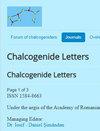Impact of aluminum fluoride addition on crystallization, structure and thermal properties of lead borate glasses
IF 1.2
4区 材料科学
Q4 MATERIALS SCIENCE, MULTIDISCIPLINARY
引用次数: 0
Abstract
The glass composition (70-x)PbO–(30-y)B2O3–(x+y)AlF3, where x and y ranges from 0 to 20 mol%, were prepared using the conventional melt-quenching-annealing technique. The structural and thermal properties of the glasses were comprehensively analyzed using techniques like Differential Thermal Analysis (DTA), Dilatometry, Fourier-Transform Infrared Spectroscopy (FTIR), X-ray Diffraction (XRD), and Scanning Electron Microscopy (SEM). XRD confirmed the amorphous, non-crystalline structure of the glasses. The glass network was found to be composed of structural units such as PbO4, BO4, BO3 and AlO6 using FTIR spectroscopy. FTIR analysis revealed significant structural changes, including the transformation of BO4 to BO3 units and the increase in non-bridging bonds, particularly with higher AlF3 content. DTA was instrumental in determining characteristic temperatures, such as the glass transition, melting, and peak crystallization temperatures, along with glass stability parameters (∆T, Hr, Tgr) for all samples. The study found that the addition of AlF3 led to a decrease in these characteristic temperatures when replacing B2O3, but an increase when replacing PbO. Variations in the density and thermal expansion of the lead borate glass were observed upon the addition of AlF3, decreasing when substituting for PbO and increasing when substituting for B2O3. These findings provide insights into the properties of oxyfluoride glasses, paving the way for future optimization in their composition for varied applications.添加氟化铝对硼酸铅玻璃的结晶、结构和热性能的影响
采用传统的熔融-淬火-退火技术制备了玻璃成分 (70-x)PbO-(30-y)B2O3-(x+y)AlF3 (其中 x 和 y 为 0 至 20 摩尔%)。利用差热分析(DTA)、稀释法、傅立叶变换红外光谱(FTIR)、X 射线衍射(XRD)和扫描电子显微镜(SEM)等技术对玻璃的结构和热性能进行了全面分析。X 射线衍射证实了玻璃的非晶态结构。傅立叶变换红外光谱发现玻璃网络由 PbO4、BO4、BO3 和 AlO6 等结构单元组成。傅立叶变换红外光谱分析揭示了明显的结构变化,包括 BO4 单元向 BO3 单元的转变以及非桥键的增加,尤其是 AlF3 含量越高时。DTA 有助于确定所有样品的特征温度,如玻璃化转变温度、熔化温度和结晶峰值温度,以及玻璃稳定性参数(ΔT、Hr、Tgr)。研究发现,在取代 B2O3 时,添加 AlF3 会导致这些特征温度降低,但在取代 PbO 时则会升高。加入 AlF3 后,硼酸铅玻璃的密度和热膨胀率也发生了变化,取代 PbO 时密度和热膨胀率下降,取代 B2O3 时密度和热膨胀率上升。这些发现有助于深入了解氟化氧玻璃的特性,为今后优化其成分以满足不同应用的需要铺平了道路。
本文章由计算机程序翻译,如有差异,请以英文原文为准。
求助全文
约1分钟内获得全文
求助全文
来源期刊

Chalcogenide Letters
MATERIALS SCIENCE, MULTIDISCIPLINARY-PHYSICS, APPLIED
CiteScore
1.80
自引率
20.00%
发文量
86
审稿时长
1 months
期刊介绍:
Chalcogenide Letters (CHL) has the aim to publish rapidly papers in chalcogenide field of research and
appears with twelve issues per year. The journal is open to letters, short communications and breakings news
inserted as Short Notes, in the field of chalcogenide materials either amorphous or crystalline. Short papers in
structure, properties and applications, as well as those covering special properties in nano-structured
chalcogenides are admitted.
 求助内容:
求助内容: 应助结果提醒方式:
应助结果提醒方式:


